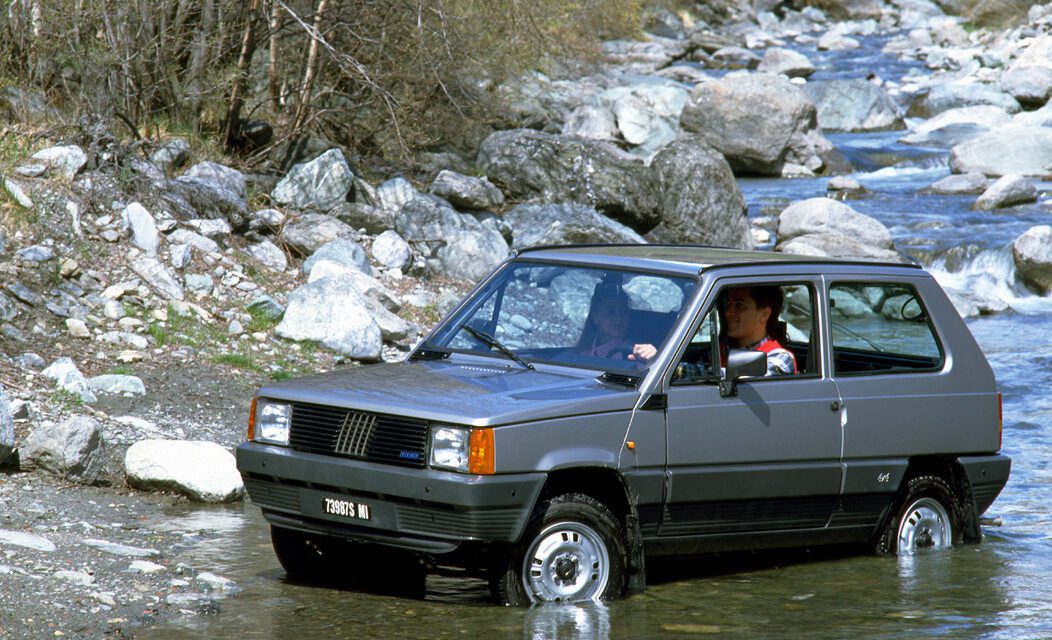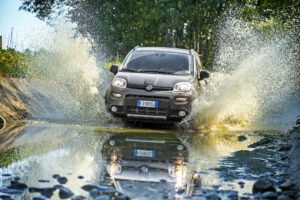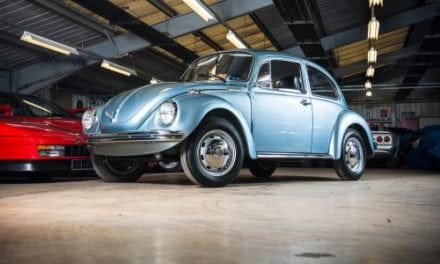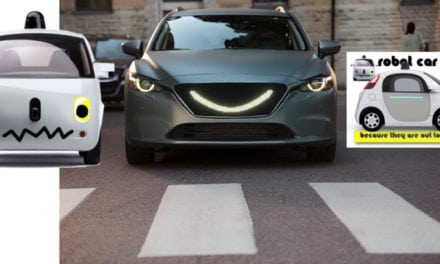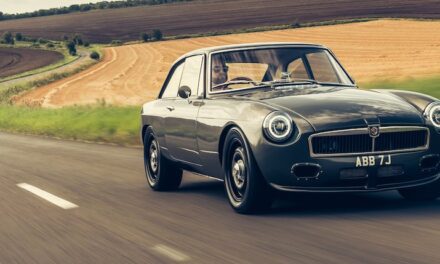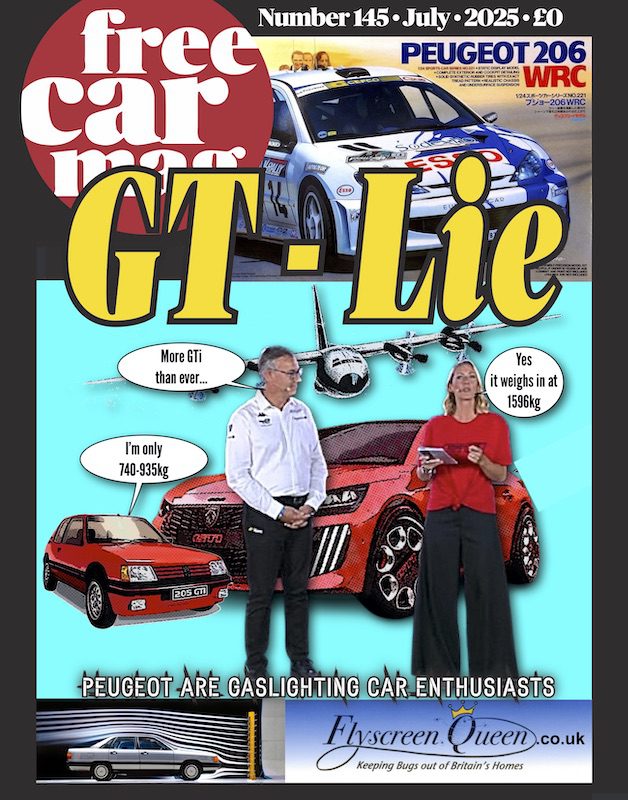The timeless Panda 4×4 is turning 40. The perfect embodiment of Italian style and a genuine icon, the legendary FIAT model combined the comfort of a city car designed for families with extraordinary performance on the toughest terrains.
The Stellantis Heritage team is marking the occasion with two gifts: an evocative video clip (above) taking a look back at some of its most exciting adventures around the world and the restoration of a Trekking version of a 2001 Panda 4×4—a low-mileage model which acted as a company vehicle at the Mirafiori factory in Turin for its entire life.
Restored to its original splendor, the vehicle has been put up for sale and made its debut at the recent Auto e Moto d’Epoca in Bologna, arousing curiosity and praise for the conservation work carried out by the Heritage team.
Roberto Giolito, Head of Stellantis Heritage (Alfa Romeo, Fiat, Lancia, Abarth), stated: “In a world in constant flux, the Fiat Panda 4×4 was able to leave an indelible mark on people’s lives, accompanying them over 40 emotional and freedom-filled years, as attested by the over 800,000 units solid between 1983 and today. Moreover, the Panda 4×4 was created with a bold and confident attitude to take on outdoor adventures, whatever the weather or road conditions. And the 2001 Panda 4×4 Trekking we have restored is no exception. After having operated in the Turin Mirafiori factory, we thought that the moment had come to return it to its natural habitat: adventurous routes, mountain ascents, or, simply, a nice ride in the city center. We are proud of this vehicle which will bring the happiness and lightheartedness of the past to a collector who is passionate about Made-in-Italy vehicles.”
The first generation, the star of the most thrilling adventure races on earth
The history of the Panda 4×4 begins in 1983, just three years after the official debut of the model designed by Giorgetto Giugiaro—i.e., the famous compact two-volume, two-door, front-wheel-drive hatchback. Building on the Panda’s initial success, FIAT decided to launch a four-wheel-drive version with both excellent off-road characteristics and, most of all, an affordable price—in full respect of the company’s manufacturing philosophy aimed at making the most advanced technology simple and accessible to everyone, in addition to providing the trademark charm and joy of the Italian lifestyle.
That’s why FIAT called upon Steyr-Puch, a leader in the four-wheel-drive sector, in 1983 to turn the versatile city car into a small and light off-road vehicle. Specifically, the 4×4 system developed for the Panda was simple and robust: one just needed to pull the gear lever on the tunnel to give traction to the rear wheels without the support of a center differential—hence, the recommendation to use it on low grip surfaces and at a low speed. Production took place in two phases: in Austria the entire transmission was produced (the clutch, the gearbox, the drive shaft in three parts, the rear axle with differential, and brakes) and then shipped to the Fiat factory in Termini Imerese (PA) to be assembled with the rest of the vehicle. The five-speed gearbox was another unique feature on the full-wheel-drive model, where the so-called “primina” stood out—i.e. a drive ratio which was short enough to climb the most treacherous slopes with a certain amount of ease.
Equipped with a 965 cm³ 48 HP engine, which was later increased in the final versions in displacement to 1108 cm³, the Panda 4×4 is the first example of a city car with a transverse engine and 4WD system.
In addition to the four-wheel-drive system, the new vehicle featured a minimum ground clearance of around 18 cm, an unladen weight of just 740 kg, and optimal off-road angles which allowed it to take on slopes of almost 50%. Its off-road features also included knobby tires and protective strips on the lower part of the sides and around the wheel arch. These characteristics made it the ideal vehicle for both daily use and tackling the most treacherous roads. Furthermore, it featured an unbeatable price which made it accessible to everyone. In addition to the “base” and “S” versions of the Panda 4×4, various trims followed over the course of the years, including Trekking, Country Club (a version equipped with an inclinometer on the dashboard which measured the vehicle’s inclination angle), and the limited-edition Panda 4×4 Sisley with special interiors and a fully loaded set of features.
The perception of it as an unstoppable explorer was enhanced and confirmed after taking on numerous adventures around the world, like the legendary adventure races organized by the “Safariland” tour operator for amateur drivers who wanted to traverse the continent via off-road tours on board the Panda 4×4. The first of these adventures took place in 1985 when 50 Panda 4x4s took part in the African adventure race, starting from Rome and first stopping in Tunis and later in Abidjan—a city in the Ivory Coast which is 14,000 kilometers from Italy and only accessible via Saharan desert roads. The Sahariland format was so popular that other adventure races followed over the years. For example, in 1986/1987 a caravan of Panda 4x4s took on, and conquered, the twists and turns of over 7,000 kilometers of the insidious Australian outback. The same took place for the adventure races organized in Iceland amongst icebergs and geysers in the summer of 1987, as well in the one set in the dense Amazon Forest between 1987 and 1988. And once again, during the winter of 1989, 50 Panda 4x4s put themselves to the test in the mystical and mysterious land of India. However, the most thrilling one might just have been the adventure race between Paris and Beijing in 1989, which stretched over 11 countries and 22,000 kilometers. Despite performing as well as ever, the Panda 4×4 caravan never made it to the Chinese capital due to the social unrest taking place during the Tiananmen Square protests. However, in the spring of 1985, the Marco Polo Expedition organized by the explorer and television producer Beppe Tenti did make it and traveled the entire length of the Silk Road, from Venice to Beijing, on board three Panda 4x4s and an Iveco 4×4 vehicle. It was the first time that Western vehicles had crossed the Himalayas to reach Lhasa (Tibet) and Beijing.

The second generation: on top of the world
Passion for adventure also characterized the second generation of the Panda 4×4—the version based on the new model which made its debut in 2004 and winner of the prestigious “Car of the Year 2004” award. Produced in the Polish factory in Tychy, the first models of the second generation were the Panda 4×4 and its “Climbing” version. These would be followed by the Cross version, which stood out for its innovative front with completely redesigned bumpers and new circular headlights. Two engines were available for the range: the 1.2 60HP gasoline engine and, starting from the end of 2005, the 1.3 Multijet turbodiesel 69HP engine which significantly contributed to making the Panda 4×4 the highest-selling off-road vehicle for three consecutive years (2006, 2007, and 2008). The most important new feature was the move from part-time four-wheel drive on the Panda 4×4 to a permanent four-wheel system, which was completely mechanical and equipped with a viscous coupling (later replaced by an electro-hydraulic clutch in 2008). Specifically, the 4×4 system automatically started working as soon as it detected a loss of grip on the front wheels, gradually transferring the torque to the rear axle. Standing out on the exteriors, there were protective strips on the sides in unfinished plastic and reinforced bumpers, which were also given a buffer shield and not painted in the body’s color.
Following in the footsteps of the first generation, the Panda 4×4’s second generation was put to the test on some of the most torturous and dangerous routes. In 2005, starting from Kathmandu, at around 1,355 meters above sea level, the team captained by Angelo D’Arrigo—the Italian aviator and hang glider who wanted to hang glide from the highest mountain range in the world—took on the steep paths of the Himalayan range on board two Panda 4×4 while using a low-quality fuel—partly out of necessity and partly to put the model to an even tougher test. After having passed through Nepal and reaching the Everest base camp, 5,200 meters above sea level, the Panda 4×4 silenced its skeptics and put its adventurous and fighting spirit on display for the whole world to see.
The third generation completes the legendary Dakar 2017 rally
The baton was passed on to the third generation of the Panda in 2012. Designed by Roberto Giolito, it was inspired by the stylistic concept of the “Squircle”, i.e., a geometric form created through the meeting of a square and a circle, in which the first represents efficiency and robustness, and the second, enjoyability and flexibility. The result is a regular and agile element which is also fun and playful—just like the friendly and versatile Fiat Panda.
Produced once again in Italy (at the Gianbattista Vico factory in Pomigliano d’Arco in Campania), the new Panda 4×4 was given aesthetic reinforcements which were made to protect the body during its treacherous travels. Meanwhile, at a technical level, the vehicle was completely redesigned to give it the authentic characteristics of a top-of-the-line off-road vehicle. In just 3.7 meters, three unique characteristics on the automobile scene were combined: the exterior dimensions and agility of a city car; the performance and features of an SUV in a higher segment; and the classic traction system of a true off-road vehicle. Specifically, it included a permanent four-wheel drive system with Electronic Locking Differential (ELD) which distributed the driving force between the wheels of the same axle in the moment in which one or both started to lose grip. It should be noted that ELD was introduced for the first time in the segment on the Panda 4×4. Its adventurous look and numerous technological innovations definitely contributed to it being recognized as the “SUV of the Year 2012” by the prestigious English magazine Top Gear.
Interestingly, the winter of 2012 witnessed the creation of the Panda Monster Truck: a prototype made by FIAT in collaboration with Mercurio Cinematografica, the set designer Andrea Faini, and the Fabio Gementi garage. Fully functional, the special vehicle put a Panda 4×4 onto the platform of a Jeep CJ7 4200 and was equipped with road tractor wheels with “High Speed” tires (150 cm in diameter and 50 cm wide) which were mounted via specifically lathed solid-iron flanges. The result was a “Big Foot” Panda which was 390 cm tall (measured at the withers), 380 cm long, and 250 cm wide. Only a few weeks of work were needed to put it together. The Fiat Panda Monster Truck was used in a series of a commercials made by the Leo Burnett agency and is currently conserved at the Heritage Hub in Turin.
The Cross version came to being in 2014. It was a further advancement compared to the 4×4 thanks to its renovated look aimed at greater body protection, new electronic technologies, and, especially, new engines. However, the most important addition was the “Torque on demand” system which allowed the drive to select the vehicle set-up and traction system between three different levels: Auto, Lock and Hill Descent.
The third generation of the Panda 4×4 was also put to the test on the most extreme and treacherous routes around the world. For example, in 2017 a Panda 4×4 Cross, which was renamed PanDakar, took on the legendary Dakar rally. It was the first Fiat vehicle, derived from a city car, to cross the finish line of the most famous adventure race. Led by the Orobica Raid team made up of the veterans Giulio Verzeletti and Antonio Cabini, the PanDakar successfully completed every leg of the competition, passing through Argentina, Bolivia, and Paraguay across almost 9,000 km—4,000 of which took place on grueling special stages. Equipped with a powerful 2.0 Multijet 180 HP engine, the vehicle underwent every type of stress: 7 special stages went for more than 400 km, including one of which went over 500 km; for 5 days and more than 2,2000 km, the vehicle and team had to face low levels of oxygen due to the altitude, which never went below 3,500 meters. Moreover, the temperatures, which were often higher than 40° Celsius, combined with extreme weather conditions, put both the PanDakar and the team under enormous strain. Furthermore, it is even more impressive if you consider that, out of 93 initial teams, just 53 completed the race.
Last but not least, the indomitable Panda 4×4 became the star of the Panda raid, a long-distance and endurance amateur rally held every March in which more than 300 teams from around the world take on a course with seven stops in the Moroccan desert, without the help of GPS and only with maps and compasses. The 2024 edition will take place from March 1st to 8th and, as always, will see the participation of both historic and recent Pandas, 4x4s and simple front-wheel drive versions, in honor of the passion and freedom which the Fiat icon has been able to provide for 40 years. For this reason, as well, FIAT has recently decided to produce an four-wheel-drive anniversary edition of the Panda called the “4×40” which is available in just 1,983 models to pay homage to the year in which it got its start.
The Panda 4×4 Heritage, experience new and thrilling adventures
Created in March 2002, the Panda 4×4 Heritage—a Trekking version—is part of “Reloaded by Creators”—the parent company’s project which restores classic vehicles and puts them on the market.
Following a conservation restoration, it is now ready to be purchased by a fan who would like to experience new adventures on board a vehicle with an exhilarating past. Impressively preserved for its age and equipped with a 1,108 cc and 54 HP engine, this model has never left its original factory, as it was used for traveling around Mirafiori. In great shape and with less than 40,000 km of mileage, this Panda was the ideal candidate for restoration and placement on the market. Every mechanical detail was revisited with the trademark precision of the Heritage department’s Officine Classiche; the body, even if it was still intact, was recoated to restore it to its original shine. Meanwhile, the interiors are incredibly well-preserved and remain in their original form, making them even more unique. Dazzling and freshly restored, this collector version is ready to discover the world with a bit of customization from the Heritage department. Moreover, its twin is on full display at the Heritage Hub in Turin.

